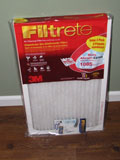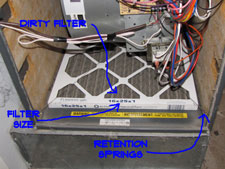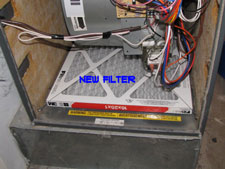Furnaces
Furnace Filter Types
 Selecting a furnace filter will mean that you have to choose the type that you want. There are different types and ratings as to quality.
Selecting a furnace filter will mean that you have to choose the type that you want. There are different types and ratings as to quality.
Furnace filters are rated by how well they trap particles in the air. The smaller and greater quantity of particles trapped, the better the filter, more or less.
There are different types of filters that you can get. They range from a disposable fiberglass filter to an electronic air cleaner. HEPA filters, the kind used in hospitals are the best at removing allergens and dust. However, the down side is that they restrict the air flow. Most residential furnaces are not equipped for the added resistance.
The question becomes, how concerned with allergens are you? You have to weigh that against cost for your furnace filter replacement project. When allergies are a problem, the extra cost is worth it.
There are some rating systems for furnace filters. The MERV rating (1 to 11, the higher the number the better)is sponsored by the American Society of Heating, Refrigerating, and Air Conditioning Engineers (ASHRAE) and is intended for comparison use.
The MPR system uses numbers up to 1250, with the higher numbers being better. Obviously, the better quality filters cost more. For a discussion on all the types of furnace filters, go to 'Types of Furnace Filters'. Find out what you need to know to make a good decision.
Types of Filters
Understanding furnace filter types is important if you have members of your family with health issues. Allergies and respiratory problems are adversely affected by poor air quality. Getting the right type of filter can improve the purity of the air in your home.
There is no question, better filters will cost more. Compared with trips to the doctor the added cost may be insignificant. Add to that the breathing discomfort that you or someone else in your home may experience, and cost pales in importance.
Do you understand the rating systems for furnace filters? See the article 'Understanding Furnace Filter Ratings' for more information. Do you need to know how to replace your furnace filter? See the article 'Furnace Filter Installation' for instructions.
Below you will find listings for some common furnace filter types. Cost needs to be weighed against a families health concerns when selecting a filter.
Disposable Fiberglass Filters
These types of furnace filters are the least expensive ones to buy. You can probably find one that fits your furnace for a couple of dollars. You can buy a package of 12 for around $20. That sounds great. Well it is if cost is your only concern.
Unfortunately, the lower cost also means lower performance. These types of furnace filters will have MERV ratings between 1 and 4. The do an adequate job of removing dust from the air. For other things like bacteria, mold, pollen and small dust particles, they do a poor job. For homes that have people with allergies, they are not suitable.
Washable Electrostatic Filters
Electrostatic types of furnace filters are generally permanent and can be washed. They work by generating a positive charge that causes the dust to stick to the media. They are more expensive than disposable filters. However, considering that they are permanent the cost savings over the long haul can be significant. This type of furnace filter can be washed out with a hose, allowed to dry an put back in the furnace. The price range for a filter of this kind is between $50 and $200.
Electrostatic furnace filters do not have MERV ratings, because they are not a dry filter media. You will have to rely on information from the manufacturer to determine the performance of the filter.
There are some pleated disposable filters that also generate an electrostatic charge. This is perhaps getting the best of both worlds. These filters boast electrostatic charges for dust particles and quality pleated filter
Pleated Allergy Filters
Pleated allergy types of furnace filters are as the name implies, pleated. The pleating allow for better air flow while still filtering out small particles. These types of filters are good at removing common allergens and fine dust from the air.
This increased performance does not come without cost. This type of filter runs between $5 and $20 each. Most of them are good for three months before they need replacing. For homes that have people with allergies, they are a must.
These types of furnace filters will usually have MERV ratings of between 7 - 9 and MPR ratings of 600 - 1500. They are suitable for residential heating systems.
Electronic Air Cleaners
Electronic air cleaners are another piece of equipment that attaches to your heating and air conditioning system. The are fairly expensive, upwards of $1,500 installed. In addition they require regular maintenance and filter replacement.
The advantages are that they eliminate a higher percentage of contaminants from the air. For those with allergies or other health problems, this peace of mind may be worth the added expense. You have to have an hvac contractor install the system for you, since it has to be integrated with your duct work. Once installed, you can maintain it a replace the filters yourself.
Activated Carbon Filters
The addition of activated carbon to a furnace filter will help with odor control. Cooking, pet or smoke odors can be removed with activated carbon. The activated carbon is added to a pleated filter media that eliminates the other types of particles. These types of furnace filters are a little more expensive than the pleated allergy filters. When odors are a problem, you may not mind the extra expense.
Activated carbon filters can have a MERV rating, similar to other style filters. A rating of 8 should be possible. This is a good rating for a residential heating system.
HEPA Filters
HEPA stands for 'High Efficiency Particulate Air'. These are the best filters you can get for removing small contaminants. The problem is that they seriously restrict the flow of air in your ventilating system. Commercial buildings such as hospitals use this type of filter. They design the hvac systems for the reduced air flow.
There are some pleated allergy filters that claim to be HEPA rated. They may carry a MERV rating of 12. A filter like this will likely be suitable for a residential furnace. When in doubt, check with the manufacturer of your furnace or your furnace maintenance contractor.
Determining Furnace Filter Size
 Furnace filters come in a lot of shapes and sizes. Determining the furnace filter size is the first step in purchasing a new filter.
Furnace filters come in a lot of shapes and sizes. Determining the furnace filter size is the first step in purchasing a new filter.
The quickest way to find the size of your filter is to get it off of the old one. There are a few places your filter could be located.
Up Flow Furnaces
This type is probably the most common. An up flow furnace as the name implies pushes the warm air up. The filter will be located at the return air portion of the furnace which will be at the bottom. It can be inside of the furnace below the blower or on the side, between the cold air return and the furnace.
Down Flow Furnaces
On a down flow furnace the cold air comes in from the top. The Filter will be above the blower. This type is often an inverted vee that requires two filters.
Horizontal Furnaces
This style is usually located in a crawl space or an attic. The filter will be on one side or the other, again at the return air side. It will likely be the style that slided in to the duct work. There should be a removable cover.
Finding the Size
Furnace filters are sized by width, length and thickness. The size on the filter is usually expressed in inches (example: 16"x20"x1"). A filter that is the wrong size will typically not fit, or may not stay in place, once installed.
The owner's manual for your furnace should tell you what size you need. Don't have your owner's manual? You can try searching online if you know the model number of your furnace. Try Manuals Online to see if you can get a copy of your owner's manual. Or try the manufacturer's website for the furnace that you have.
A low tech method would be to measure the filter that you have in your furnace now. Take out the old filter and measure it. Width, length and thickness, write them down and you're all set.
Furnace Filter Installation
This article provides information about 'Furnace Filter Installation'. This is a fairly easy maintenance and repair activity that you can perform yourself in just a few minutes. Of course you will need to have the correct furnace filtter on hand before you begin.
There are a few considerations begore you begin. (1) 'Determining Funace Filter Size' covers getting the size right. (2) 'Types of Furnace Filters' helps you select the right one for your situation.
Reasons for Installing Furnace Filters
Forced air furnaces circulate warm air through your home. Houses with central air conditioning also use the furnace to distribute cool air. When the air circulates, it picks up dust and other particulate that is not good for you. The filter catches the dust and keeps it from going back into your home.
How well your furnace filter performs will depend on several factors. The first and foremost concern is the health of your family. Allergies, respiratory problems and other breathing disorders can make the concern about your furnace filter acute. Not only do you want to replace the filter regularly, you also want to replace it with the right type. You should review the articles 'Types of Furnace Filters' and 'Furnace Filter Ratings' if you have health concerns.
This process works pretty well as long as the filter is changed regularly. A clogged filter will restrict the amount of air that can pass through it. This makes your furnace work harder to push the air. In addition, some of the dust and germs will get back into the system. Don't despair, filters are cheap and easy to change.
Furnace Filter Installation - Information
What Can You Save? - Getting someone out to your home is the expensive part. Likely $50 to $75 just for the service call. Furnace filters can vary in price dramatically. From just a few dollars on up to fifty or more dollars. The cost of a furnace filter replacement goes up dramatically when you get a HEPA style filter.
How Hard Could It Be? - A furnace filter replacement project is not hard at all. A few minutes and it's all done. These repairs will have a Difficulty Level of: Easy. These repairs require a Skill Level of: Total Novice. For and explanation of the terms in this section, see 'How to Use This Site'.
Check the Simple Things! - Replacing a furnace filter is pretty simple already. Some types can be cleaned, thus saving the cost of a new filter.
What Can Go Wrong? - Furnace filters trap dust and other pollutants in the fibers. Use caution when removing a dirty filter. You don't want to spread the dirt everywhere. Regular replacement is important. The longer a filter stays in place the more dirt it will collect. They become unhealthy when neglected.
Furnace Filter Replacement – The Steps Involved
The first thing you need to know when you replace your filter is the size. 'Determining Furnace Filter Size' covered how to locate the size of your filter.
The type of furnace filter you buy also matters. The article 'Selecting a Furnace Filter Type' talked about what your choices might be and where to go for more information.
Removing a Furnace Filter
 Removing a dirty furnace filter is probably not your first choice for things to do. The old filter can be quite dusty.
Removing a dirty furnace filter is probably not your first choice for things to do. The old filter can be quite dusty.
If you have allergies or are bothered by dust, you will want to wear a dust mask. A dirty filter can contain dust, bacteria and viruses that have been airborne in your home.
Begin you furnace filter replacement by locating your old filter. The furnace filter is located between the return air duct and the blower. This can be inside the furnace or in the duct work next to the furnace. See the article 'Determing Furnace Filter Size' for more information on locating the filter.
A filter that is located on the side will likely have a door of some sort. When the door is open the filter will slide out to remove it.
Remove the cover plate to expose the old filter. It should have retaining springs or clips that hold it in place. Remove the springs and slide the old filter out.
Have a plastic bag handy to keep the dust from getting airborne again. Dispose of the old filter. Use a vacuum to remove any residual dust before you install the new filter.
Installing a Furnace Filter
 Installing a new furnace filter is easy once you have removed the old one. See the information on removing an old filter if you haven't taken the old one out yet
Installing a new furnace filter is easy once you have removed the old one. See the information on removing an old filter if you haven't taken the old one out yet
This is fairly simple, but there are mistakes you can make with a furnace filter replacement. Most filters have wire retainers that hold the medium in place. The wire retainers should be facing the blower.
Look on the side of the filter for an air flow arrow. This will indicate the correct way to turn the filter. The air will move from the cold air duct into the furnace. When the filter is inside and on the bottom of the furnace it will be coming from the bottom up.
On an up flow furnace, the blower is located at the bottom of the furnace. On a downflow furnace it will be located at the top of the furnace. For a horizontal furnace, it will be on one side or the other.
Unpack the filter and install it with the wire turned the right way. Put the retaining springs or clips back in place. Put the cover plate back on. That's all there is to a furnace filter replacement, pretty simple.
Furnace Filter Maintenance
Furnace filter maintenance means changing your filters regularly. There are both cost and health issues to be concerned with.
The recommended length of time between furnace filter replacements varies with who you talk to. Some will suggest as often as once a month. The longest possible duration would be annually.
The quality of the filter has a bearing on this. Cheaper filters will need to be changed more often.
For $5 or $6 you can get a pleated filter with a decent rating that will last for three months. This is the duration most often recommended. From a practicality and cost standpoint it seems reasonable.
Waiting longer than three months is not a good idea. A dirty filter will make your furnace work harder and will affect your families health. Filters are often sold in bulk packs and you can get a years supply in one trip.
Take ten minutes every three months and engage in a rewarding furnace filter replacement project. You will enjoy that deep breath you are able to take afterwards.
Summary
Did you learn everything you wanted to about a furnace filter replacement project? Not much to it, but it is an important maintenance item. Keeping up with this on a regular basis will save you in furnace repairs later.
The other important reward is your families health. Fewer trips to the doctor will make everyone happy. Stocking up on furnace filters even makes this an easier repair. Just remember when the weather changes, to change the filter.


